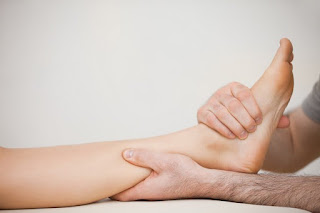Peritendinitis Symptoms, Causes, Treatment | Achilles Peritendinitis
Peritendinitis is defined as the inflammation of paratenon. Paratenon is the sheath covering tendons all over the body. Peritendinitis resembles tendinitis in which inflammation of tendon itself occurs. It occurs commonly in people who are used to hard work like athletes and gym guys. Paratenon covers the tendon and help in its movement by reducing friction. So in peritendinitis, the tendon cannot move smoothly. It is a sensitive case. Because moving the stiff tendon with high friction can break it and patient won't be able to move any more. When the inflammation occurs in paratenon, tendon becomes stiff and hard to move freely.
Peritendinitis involves tendons (joining muscles to the skeleton). When inflammation occurs in paratenon (covering of tendons), it makes the tendon stiff. Patient find it hard to move freely. Severe pain occurs while moving the affected region of body. Limited motion can be produced. On touch, the affected site feels hot and swollen. Swelling occurs on the whole part involved in peritendinitis. Telltale sound is produced while moving the affected site of body. Telltale sound is the cracking sound which produces because of paratenon inflammation and more friction. During inflammation, the surface of tendon looks cracked like water dries up leaving the earth surface cracked.

There is not any defined cause behind peritendinitis. Scientists believe that it can occur secondary to tendinitis which is the inflammation of tendon itself. Inflammation of paratenon occurs due to excessive workout. It commonly occurs in male gender. Athletes and gym guys are at the hit list because they got little time to rest their body and workout most of the time. Moving the limbs excessively can increase the chances of peritendinitis as kneading the dough in restraunts most of the time can cause peritendinitis in wrist or elbow.
Initially, patient is asked to take rest for atleast a week or until the swelling and pain reduces or subside. Some adaptive devices like crutches are used to take off burden from tendons for faster healing. Patient is asked to compress the inflamed area with hot water or cold ice. As it will naturally help a lot in reducing inflammation and muscle relaxing. Tests should be performed regularly with one week interval to check progress. If no progress occurs, then steroid injection is the solution. But it's administration is quite complicated. It should be injected in paratenon not in the tendon.
Achilles is the tendon present in heels. It is a fibrous tissue tough band which connects the heel bone to the calf muscles. Calcaneal tendon is the other name of Achilles tendon. When inflammation of paratenon of Achilles tendon occurs, it is known as Achilles Peritendinitis. Achilles tendon is the most common tendon involved in peritendinitis because heels and feet are the most working part of our body all the time. The symptoms are same I.e. pain and swelling and stiffness. Patient with Achilles Peritendinitis will take at least 15 days to recover with complete bed rest.
Peritendinitis Symptoms
Peritendinitis involves tendons (joining muscles to the skeleton). When inflammation occurs in paratenon (covering of tendons), it makes the tendon stiff. Patient find it hard to move freely. Severe pain occurs while moving the affected region of body. Limited motion can be produced. On touch, the affected site feels hot and swollen. Swelling occurs on the whole part involved in peritendinitis. Telltale sound is produced while moving the affected site of body. Telltale sound is the cracking sound which produces because of paratenon inflammation and more friction. During inflammation, the surface of tendon looks cracked like water dries up leaving the earth surface cracked.

Peritendinitis Causes
There is not any defined cause behind peritendinitis. Scientists believe that it can occur secondary to tendinitis which is the inflammation of tendon itself. Inflammation of paratenon occurs due to excessive workout. It commonly occurs in male gender. Athletes and gym guys are at the hit list because they got little time to rest their body and workout most of the time. Moving the limbs excessively can increase the chances of peritendinitis as kneading the dough in restraunts most of the time can cause peritendinitis in wrist or elbow.
Peritendinitis Treatment
Initially, patient is asked to take rest for atleast a week or until the swelling and pain reduces or subside. Some adaptive devices like crutches are used to take off burden from tendons for faster healing. Patient is asked to compress the inflamed area with hot water or cold ice. As it will naturally help a lot in reducing inflammation and muscle relaxing. Tests should be performed regularly with one week interval to check progress. If no progress occurs, then steroid injection is the solution. But it's administration is quite complicated. It should be injected in paratenon not in the tendon.
Achilles Peritendinitis
Achilles is the tendon present in heels. It is a fibrous tissue tough band which connects the heel bone to the calf muscles. Calcaneal tendon is the other name of Achilles tendon. When inflammation of paratenon of Achilles tendon occurs, it is known as Achilles Peritendinitis. Achilles tendon is the most common tendon involved in peritendinitis because heels and feet are the most working part of our body all the time. The symptoms are same I.e. pain and swelling and stiffness. Patient with Achilles Peritendinitis will take at least 15 days to recover with complete bed rest.
Peritendinitis Symptoms, Causes, Treatment | Achilles Peritendinitis
 Reviewed by Simon Albert
on
April 20, 2019
Rating:
Reviewed by Simon Albert
on
April 20, 2019
Rating:
 Reviewed by Simon Albert
on
April 20, 2019
Rating:
Reviewed by Simon Albert
on
April 20, 2019
Rating:











